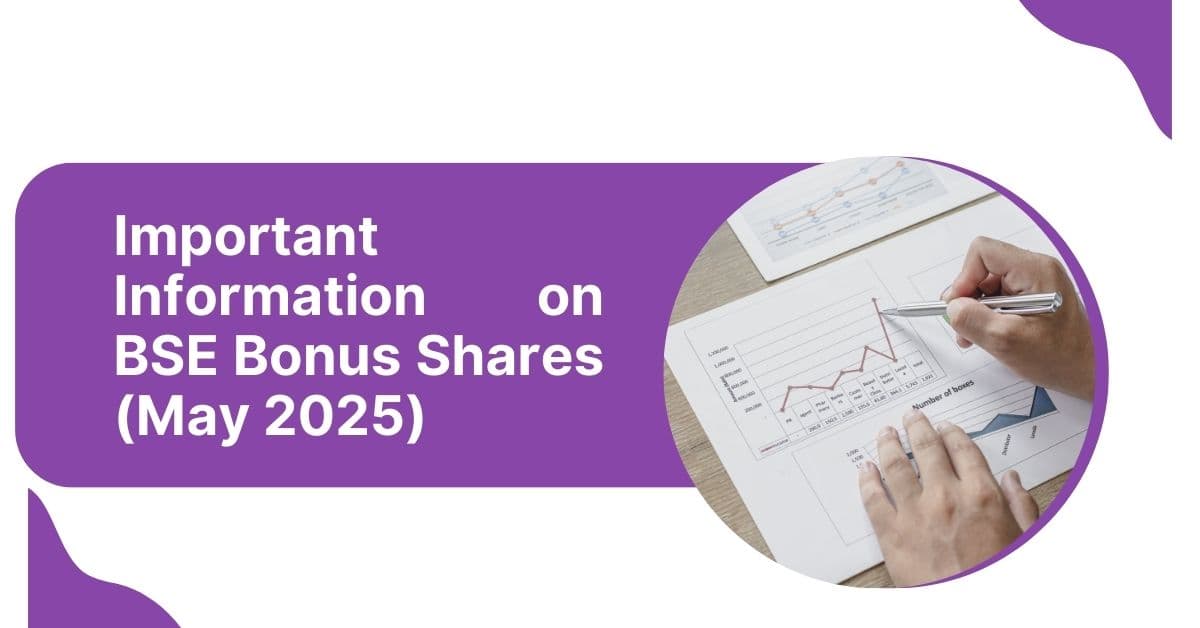BSE Bonus Shares: The oldest stock exchange in Asia, BSE Ltd., created news in May 2025 when it announced a 2:1 bonus share issuance, giving stockholders two more shares for each share they had as of the record date, May 23, 2025. As India’s financial markets are driven by the Sensex at 82,530.74, 2 crore+ demat accounts, and 100 crore+ UPI users, BSE’s stock rose 30% year-to-date to ₹2,448 (post-bonus adjustment), indicating high investor confidence. According to Moneycontrol, this comes after a fantastic Q4 FY25 with ₹8.4 billion in sales and ₹494 crore in net profit (up 362% YoY). The bonus shares, which will be awarded by May 29, 2025, necessitate careful portfolio planning in order to optimise profits, particularly given that there are more than 17,000 SBI branches and platforms such as Zerodha that facilitate retail participation.
This guide examines the BSE’s bonus issue, its effect on portfolios, and budgeting techniques for paid professionals (₹5–15 lakh/year), high net worth individuals (HNIs), and beginners. It is specifically designed for Indian investors in Tier-2 cities (Patna, Jaipur) and metro areas (Mumbai, Delhi). With ₹6.81 lakh crore in digital transactions, we provide practical insights to take advantage of BSE’s expansion, diversify assets, and match objectives such as retirement or house financing (₹50 lakh+) with products like Groww and Screener.in.
Important Information on BSE Bonus Shares (May 2025)

- According to Angel One, the bonus ratio is 2:1 (2 additional ₹2 equity shares for every 1 share retained).
- Record Date: May 23, 2025; according to Moneycontrol, stockholders need shares by May 22 because of the T+1 settlement.
- According to CNBC TV18, trading started on May 27 and the allocation date was May 26, 2025.
- According to Equitymaster, a total of 274,652,718 equity shares (₹549,305,436) were issued.
- Stock Price: ₹2,448 (modified from ₹7,015 on May 23, 2025, post-bonus), according to ETMoney.
- According to Screener, the market cap is ₹99,420 crore, up 169% in a year.
- According to Business Today, the 52-week range is ₹705 (adjusted, July 2024) to ₹2,529.33 (adjusted, May 20, 2025).
- According to ETMoney, the dividend yield is 0.74%, or ₹15/share in FY24.
- According to CNBC TV18, MOFSL, analyst ratings are as follows: Buy (11/14 analysts, target ₹5,340–₹6,900).
- According to Moneycontrol, Q4 FY25 results showed revenue of ₹8.4 billion (+94% YoY) and net profit of ₹494 crore (+362% YoY).
Context: According to the RBI, retail investors in Gujarat and Uttar Pradesh are taking advantage of the BSE’s incentive by utilising UPI applications like Paytm, while 5,600+ listed businesses on the BSE and Nifty are aiming for a 15% CAGR. According to Business Today, the May 23 price decline of 67% was a mechanical adjustment rather than a loss.
Comprehending the Bonus Share Problem at BSE
India’s top stock exchange, BSE Ltd. (BSE: 0, NSE: BSE), was established in 1875 and went public in 2017. It allows trading in mutual funds, stocks, and derivatives. According to The Hindu BusinessLine, the 2:1 bonus issue, which was announced on March 30, 2025, increased paid-up capital to ₹81.22 crore by using ₹54.93 crore from reserves (Capital Redemption: ₹0.02 crore, General: ₹54.91 crore).
Why are there Bonus Shares?
- Reward Shareholders: According to Angel One, BSE’s second bonus since 2022—the first was given on February 8, 2022—reflects confidence.
- Boost Liquidity: According to Share India, tripling shares increases trading volume and draws investors.
- Boost EPS: According to CNBC TV18, capitalising reserves increases earnings per share.
- Signal Growth: According to Moneycontrol, Q4 FY25’s 362% profit spike suggests long-term potential.
Effect on Investors
- Shareholding: 100 shares before to the bonus increase to 300 shares after the bonus, per Groww.
- Price Adjustment: According to Business Today, the pre-bonus ₹7,015 dropped 67% to ₹2,448; nevertheless, the portfolio value remained same.
- Long-Term Gains: According to CNBC TV18, 300 shares will generate ₹7,26,600 in profit from ₹7,01,500 pre-bonus if the BSE reaches ₹5,340, which is Goldman Sachs’ target.
- Taxation: According to The Hindu BusinessLine, bonus shares are tax-free upon receipt; capital gains are subject to tax upon sale (15% LTCG if held for more than a year).
Context: According to AMFI, investors in Bangalore and rural Bihar use Angel One’s Hindi applications to watch the BSE, and the company has over 2 crore SIP accounts. According to @StocktwitsIndia, X tweets acknowledged the price modification uncertainty while celebrating the bonus.
Why Make a Budget for Your Portfolio Right Now?
Despite being free, BSE’s bonus shares increase the number of shares without producing an instant value gain, necessitating portfolio rebalancing to:

- Profit from gain: According to Business Today, the BSE’s 5,200% five-year rally and its 169% one-year market capitalisation gain point to an upward trend.
- Reduce Risks: According to CNBC TV18, BSE’s options market share might drop by 15% if SEBI approves NSE’s Tuesday expiration day.
- Diversify: According to Share India, over exposure to the BSE might result in losses if market mood changes.
- Fund Objectives: According to Forbes India, match investments to objectives such as weddings (₹10–20 lakh) or schooling (₹5–15 lakh).
- Optimise Taxes: According to ClearTax, plan for 15% LTCG tax on future BSE sales.
Context: According to ETMoney, salaried professionals in Mumbai (earning between ₹6 and 12 lakh annually) should budget to take advantage of BSE’s 0.74% dividend and bonus-driven liquidity, as the Sensex aims to reach 90,000.
Strategies for BSE Bonus Share Budgeting
For Indian investors with budgets between ₹10,000 and ₹50,000, the following simple methods can help you maximise your portfolio after receiving the BSE bonus:

1. Evaluate Your Portfolio
- How: List other assets (stocks, FDs, MFs) and BSE shares (e.g., 300 post-bonus from 100). Determine your exposure (three hundred BSE shares at ₹2,448 = ₹7,34,400).
- For instance, the portfolio has ₹10 lakh (₹66,000 FD, ₹2 lakh MFs, and ₹7.34 lakh BSE). The BSE is overly concentrated at 73%.
- Forbes India advises using Screener.in to monitor allocations.
Context: According to the NSE, experts in Delhi analyse demat accounts using Zerodha.
2. Adhere to the Budget Rule of 50/30/20
- 50% of needs are met by food (₹5,000), rent (₹15,000), and EMI (₹10,000), totalling ₹30,000.
- 30% of the wants are travel, OTT, and dining (₹7,500).
- 20% Investment/Savings: ₹12,500 (₹5,000 MF SIP, ₹7,344 for 3 BSE shares).
Example Plan (Monthly Salary: ₹50,000):
- Requirements: ₹25,000 for utilities and rent.
- Desires: ₹15,000 for lifestyle.
- Savings: ₹10,000 (₹2,000 SBI FD at 7.25%, ₹3,000 Parag Parikh Flexi Cap, and ₹4,896 for two BSE shares).
- According to ClearTax, if the BSE achieves ₹5,340 for 300 shares, the result would be a profit of ₹14,52,000.
- According to Economic Times, use Moneycontrol’s Budget Planner.
Context: According to AMFI, families in Patna (salary: ₹3–7 lakh/year) budget through CSC facilities.
3. Diversify to Reduce Risk
- Why: According to CNBC TV18, the BSE’s 15% possible market share loss (NSE expiration shift) necessitates balance.
- How: Put 10% in the BSE, 30% in equities (such HDFC Bank and TCS), 30% in MFs (Quant Small Cap), and 30% in FDs (PNB: 7.25%).
- For instance, a budget of ₹1 lakh includes ₹10,000 for four BSE shares, ₹30,000 for TCS, ₹30,000 for MF SIP, and ₹30,000 for FD.
- NSE India’s Market Watch is a good resource for NSE choices.
Context: According to Forbes India, joint families in Uttar Pradesh use Groww to diversify for objectives like mansions (₹50–80 lakh).
4. Reinvest Dividends
- How: 300 shares of the BSE’s FY24 dividend of ₹15/share (0.74% yield) equal ₹4,500. According to ETMoney, reinvest in MFs or the BSE.
- For instance, ₹4,500 increases SIPs or purchases one BSE share, compounding returns.
- Business Standard advises using Upstox’s dividend reinvestment option.
Context: According to the RBI, HNIs in Surat reinvest their investments (between ₹2 and ₹10 lakh) using SBI NetBanking.
5. Prepare for Tax Implications
- How: According to ClearTax, hold BSE shares for more than a year to receive 15% LTCG tax on profits (₹1.25 lakh excluded). Plan for taxes on the sale of 300 shares at ₹5,340 (gain of ₹8,62,200, tax of ₹1,03,830).
- For instance, according to Paisabazaar, save ₹10,000 per month in ELSS (HDFC ELSS Tax Saver) to offset taxes under Section 80C (saving ₹46,800).
- According to Forbes India, use the Capital Gains Calculator on ClearTax.
Context: According to AMFI, NRIs in Hyderabad arrange their taxes using Groww’s NRI platform.
6. Keep an eye on market signals
- Follow: SEBI’s expiry day decision via TradingView, Q1 FY26 results (Aug 2025), and the BSE price (₹2,448), according to Livemint.
- Advice: According to Economic Times, set alerts on Angel One for price decreases below ₹2,300 or increases over ₹2,600.
Context: According to AMFI, rural investors in Rajasthan utilise Hindi applications (Angel One) to stay informed.
7. Increase Investment Income
- How: According to Indeed, you may finance BSE purchases by working as a freelancer on Upwork (₹2,000–₹5,000/day) or tutoring on Unacademy (₹500–₹1,000/hour).
- For instance, purchasing 32 BSE shares at a rate of ₹80,000 per month (10 hours per week) at ₹2,000 per hour.
- Advice: According to Skill India, upskill through NSDC (free–₹5,000).
Context: According to Forbes India, professionals in Bangalore use LinkedIn to get employment.
8. Speak with Professionals
- How: According to ClearTax, hire SEBI-registered consultants for portfolio and tax planning through Vakilsearch (₹2,000–₹5,000).
- For instance, the advisor uses ELSS to optimise a ₹5 lakh portfolio and save ₹50,000 in taxes.
- According to Economic Times, use Moneycontrol’s Advisor Directory.
Context: According to the RBI, Mumbai’s metro investors seek advice from SBI’s 17,000+ offices.
The Risks of Not Budgeting Your Portfolio
- Overexposure: according to CNBC TV18, 73% of the BSE allocation is at danger of losses if SEBI’s expiration move affects volumes.
- Missed Gains: According to ClearTax, unbudgeted portfolios may exclude FDs (7.25%) or MFs (15% CAGR).
- Tax Penalties: According to Paisabazaar, unplanned LTCG taxes (₹1 lakh+) put a strain on budgets.
- Financial Stress: According to NIMHANS, 60% of investors express worry about market volatility.
- Lost Goals: According to Forbes India, inadequate planning postpones retirement or weddings (which cost ₹10–20 lakh).
Answers:
- Use Screener.in to track BSE.
- Utilise Groww to diversify.
- According to Reddit, join r/IndiaInvestments for advice.
Context: The RBI reports that rural communities in Bihar rely on SBI’s 7,000+ ATMs for cash and require Hindi resources such as Angel One.
Resources and Tools
- Stock trackers: Screener.in, TradingView, and Moneycontrol are stock trackers that provide BSE updates.
- Trading platforms: for UPI-based transactions include Groww, Upstox, and Zerodha.
- Tax Tools: Paisabazaar for LTCG planning and ClearTax.
- Calculators: according to BankBazaar, the Investment Calculator.
- Learning resources: include YouTube (CA Rachana Ranade), SEBI, and NSE India.
- Community: CSC centres, Zerodha University, and r/IndiaInvestments.
Context: According to the RBI, accessibility is guaranteed by more than 17,000 bank branches and 100 crore UPI customers.
Conclusion
According to Moneycontrol, BSE’s 2:1 bonus shares, which are credited by May 29, 2025, treble shareholdings (from 100 to 300), increasing liquidity and indicating growth with a 362% Q4 profit rise. BSE’s 5,200% 5-year rise and analyst expectations (₹5,340–₹6,900) imply 118–182% upside at ₹2,448 (post-adjustment), according to CNBC TV18. To reduce risks like SEBI’s expiration shift, use the 50/30/20 rule to budget your portfolio today, diversify using Zerodha, and manage taxes with ClearTax, according to CNBC TV18. Act before Q1 FY26 profits (Aug 2025) to fund goals like retirement or schooling (₹5–15 lakh), since there are more than 2 crore demat accounts and the Sensex is at 82,530.74. Take advantage of the additional chance and rebalance right now.
Call to Action: Share your portfolio strategy in comment, purchase 10 shares (₹24,480) on Upstox, and follow the BSE on Screener.in!
ITR Filing 2025 Deadline Near – Master Budgeting Before It’s Late!
AMD Share Price Alert: Budgeting Tips for Aspiring Investors!
Defence Stocks India for Beginners: Budget-Friendly Guide

